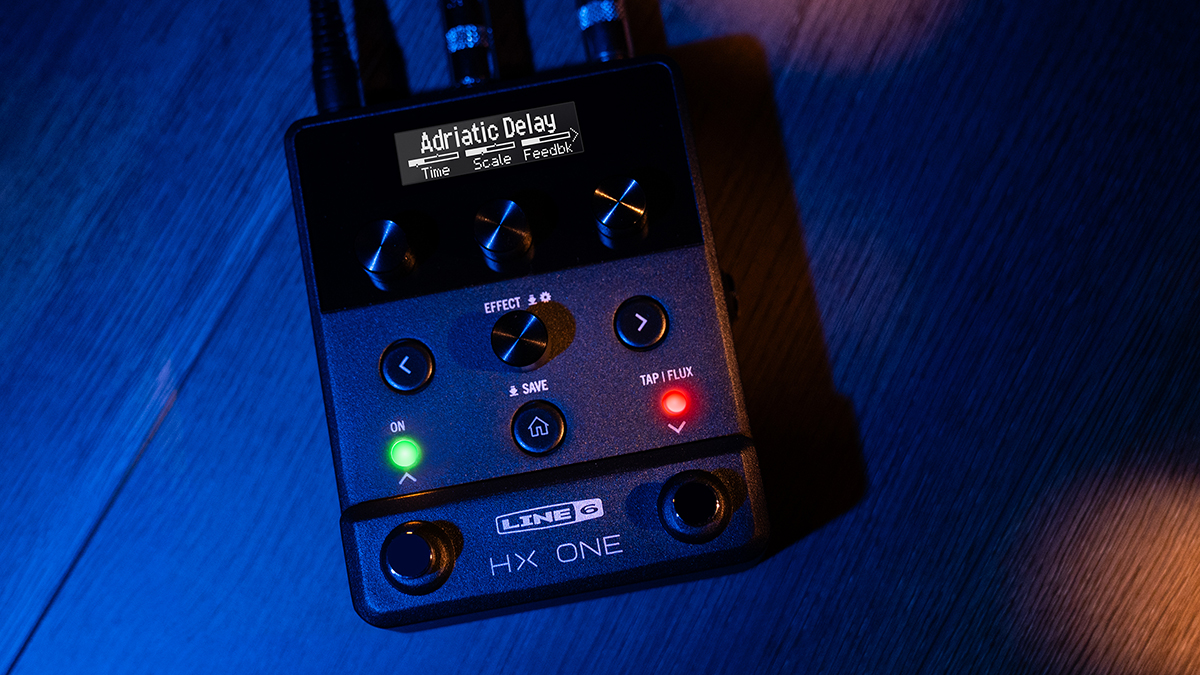Guitar World Verdict
The Line 6 HX One is perfect for guitarists who primarily use pedal-based rigs and want to incorporate Line 6’s outstanding HX effect models but don’t want to bother with complicated programming or multi-effects patches.
Pros
- +
More than 250 high-quality effect models.
- +
Simple and fast control of parameters.
- +
Innovative Flux feature generates unique effects.
- +
128 presets.
- +
Full-size 5-pin DIN MIDI jacks.
Cons
- -
Only one effect can be used at a time.
You can trust Guitar World
The Line 6 HX One offers guitarists a quick and easy way to add Line 6’s HX effect models to their rigs with minimum hassle.
The unit is about as big as an average mid-sized stompbox (like a Phase 100 but taller) so it can easily squeeze into a packed pedalboard, and its controls are smartly designed to enable quick tweaks on the fly just like a regular old effects pedal. Yet underneath its modest-looking exterior is an advanced processor that provides more than 250 pristine-sounding stereo effect models.
Unlike larger HX units that provide simultaneous multi-effects and amp models, HX One is a “one effect at a time” processor with no amp modeling, making it more of an effects stompbox with multiple personalities.
The pedal sounds good when either plugged straight into a guitar amp’s input or into an effects loop, but for optimal performance I recommend using the “four-cable method” where the signal is routed to an amp’s input and effects loop simultaneously.
Each preset can be programmed to “Pre” or “Post” insert positions, which allows users to route effects like delay or reverb to the effects loop and distortions, compressors, wahs or dynamic filters to the amp’s input. Note that using the four-cable method limits effects to mono only.

With more than 250 effects to choose from, the available selection is impressively comprehensive, encompassing dozens of distortion pedals, studio and stompbox compressors and gates, various EQs, modulation effects like tremolo, vibrato, phaser, flanger, chorus, vibe, rotary and ring modulation, delays from classic tape unit emulation to state-of-the-art digital effects, reverbs, various pitch shift and synth effects and wahs and dynamic filters.
There’s also a Looper section with Simple and Shuffling types that provide up to 60 seconds of loop recording in mono or 30 seconds in stereo.
All the latest guitar news, interviews, lessons, reviews, deals and more, direct to your inbox!
A chromatic guitar tuner function is accessed by holding down the On and Tap/Flux footswitches for about two seconds. Basically, HX One provides an impressive collection of effects that cost a little more than a dollar each.
Three parameter control knobs below the display make it easy to adjust settings quickly, just like using a regular effects pedal. Although each effect provides about 10 or more parameters, the most commonly used ones are arranged on the first page.
Page buttons scroll up and down as desired to access deeper parameters. The pedal can also be set up to scroll up and down sequentially through all 128 presets using the On and Tap/Flux footswitches, but this setup bypasses the parameter adjustment capabilities.
The Flux feature enables some rather dramatic special effects by ramping up and down several selected parameters at once, particularly when used with delay or pitch shift effects. Flux mode is easily accessed by holding down the Tap footswitch until the LED above it is illuminated in white.
HX One also accommodates a variety of footswitch and expression pedal controllers for users who prefer to tweak parameters manually during live performance.

Full-size MIDI In and Out/Thru 5-pin DIN jacks mounted on the pedal’s side are a welcome feature for users who want more sophisticated control of functions like program changes, parameter control or MIDI Clock tempo sync.
The sound quality of the HX One’s effect models is simply pristine. The distortions, overdrives and modulation effects sound rich, natural and organic
The pedal also can send and receive MIDI messages via its mini USB jack, allowing hassle-free connection to a wide variety of MIDI-capable gear and setups.
The sound quality of the HX One’s effect models is simply pristine. The distortions, overdrives and modulation effects sound rich, natural and organic, while the studio processor models are every bit as good as the most acclaimed software emulations.
The $300 street price may seem expensive for a pedal that provides only one effect at a time, but in reality it’s a bargain for a complete collection of effects that most guitarists will never grow tired of.
Specs
- PRICE: $299 / £299
- TYPE: Guitar effects modeler
- CONTROLS: Parameter knobs 1-3, Effect
- SWITCHES: Page L, Page R, Home/Save, On footswitch, Tap/Flux footswitch
- JACKS: Input L/Mono, Input Right (return), Output L/Mono, Output Right (send), Expression/Footswitch 3-4, MIDI In, MIDI Out/Thru, mini USB, 9VDC power input (adapter included)
- CONTACT: Line 6
Chris is the co-author of Eruption - Conversations with Eddie Van Halen. He is a 40-year music industry veteran who started at Boardwalk Entertainment (Joan Jett, Night Ranger) and Roland US before becoming a guitar journalist in 1991. He has interviewed more than 600 artists, written more than 1,400 product reviews and contributed to Jeff Beck’s Beck 01: Hot Rods and Rock & Roll and Eric Clapton’s Six String Stories.


